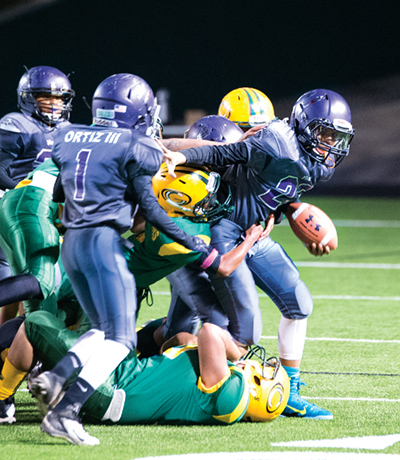Head Games
Kids want to play, but when does a knock to the head lead to brain trauma? Kinesiology Associate Professor Cindy Trowbridge is researching how to better recognize the signs of concussions.
Get up. You’ll be fine. For years, that was a typical parent response when kids took a hard hit on the playground or playing field. But growing research connecting head injuries from concussions with brain trauma and even death has many parents rethinking what sports and activities their kids play, if they let them play at all.

Dr. Cindy Trowbridge talks to parents about the signs of concussions.
Football has borne the brunt of the backlash as the NFL works to settle a $765 million lawsuit with former players charging that the league needed to do more to protect players from repeated concussions that can lead to chronic traumatic encephalopathy, a progressive degenerative disease found in people with a history of multiple concussions.
But other sports and even simple playground antics can cause concussions. The Centers for Disease Control reports that each year U.S. emergency rooms treat an estimated 173,285 sports and activity-related traumatic brain injuries in kids 19 and younger.
So what’s a parent to do?
Cindy Trowbridge, associate professor of kinesiology in the College of Nursing and Health Innovation, is researching the best ways to educate parents so they can recognize the signs of concussions and be better advocates for their active kids. A certified athletic trainer for more than two decades, she has fielded more questions in the last four years about concussions than any other injury.
“It has become clear to me that parents of youth athletes and their families still need more information about the definition of concussions and symptoms to look for, as well as the appropriate treatment protocols,” she says.
Dr. Trowbridge has made parental education a focus of her research and last year became part of a nationwide effort to coordinate a new youth sports safety program from the MomsTEAM Institute, a leading youth sports health and safety think tank and watchdog group.
She’s working with the Grand Prairie Youth Football Association in a pilot program set to go nationwide. Her efforts, including installing sensors on helmets and conducting informational talks with parents, have been featured on media outlets including NBC’s Today Show.
“Families should know the first step is understanding what makes a child’s brain unique,” she says. “Then, parents must be ready to take steps to spot concussions and take action.”
Understanding the child’s brain
Most Common Concussion Symptoms
- Headache
- Difficulty concentrating
- Fatigue
- Drowsiness
- Dizziness
- Fogginess
- Feeling slowed down
- Light sensitivity
- Balance problems
- Difficulty with memory
Concussions are a type of mild traumatic brain injury and are considered a result of traumatic shaking of the brain. They can cause acute and long-term changes in brain physiology and function, including cognition. And for children with developing brains, they can be especially dangerous.
Children have smaller brains in relation to their skulls. Compared to an adult, the young child brain has less mass and more cerebrospinal fluid between the brain and the skull. Think of it like an egg yolk—there’s room for it to move. Because children’s brains have less mass in relation to the skull, their brains experience more acceleration. This means the brain can hit the skull with more force when jolted on the playing field.
A child’s brain also appears to be far more plastic or impressionable than the adult brain. This helps during maturation; however, it can have negative effects associated with brain injury because the brain itself is less resistant to trauma.
“We can’t fix brain injuries like we can fix damage to ligaments and bones,” Trowbridge says. “Therefore, it’s important for parents to be protective when it comes to their children’s brains and to be aware of the potential long-term effects a concussion can have on normal brain development.”
Recognizing the symptoms
Recent research shows that parents have misconceptions regarding the definition, symptoms, and treatment of concussions.
Trowbridge says many don’t know that concussions can occur from trauma other than a blow to the head. They also don’t readily recognize key symptoms of concussions, including irritability and sleeping difficulties. Some people incorrectly identified arm and leg weakness or numbness as concussion symptoms.
Parents are in a prime position to recognize the signs and symptoms of a concussion in their child. The culture of sport encourages children to play and win, so a child often will hide symptoms from medical practitioners. But Trowbridge says parents can pick up on the subtle signs of problems associated with a previous concussion.
Symptoms usually are classified into four categories: physical, cognitive, emotional, and sleep patterns. The physical signs include, but aren’t limited to, headache, loss of consciousness, dizziness or balance problems, numbness, tingling, fatigue, visual problems, diminished pupil reaction, dazed or stunned expressions, ringing of ears, sensitivity to light and noise, and vomiting.
Among the cognitive responses are mental slowing or fogginess, and emotional symptoms include irritability, uncharacteristic actions, anxiety, sadness, and depression. Sleep changes such as excessive drowsiness, trouble falling asleep, and altered sleep patterns are also common.
When is it OK to play?
Unfortunately, the return to play and return to learn (or classroom) guidelines aren’t widely understood by parents and even many health professionals because of communication gaps, Trowbridge says.
“If children are treated by emergency room physicians or pediatricians, these professionals may not be trained in the long-term management of concussions,” she says. “The result: Children often return to school or athletics too soon.”
The cornerstone for both the return to play and return to learn plans is rest—physical and cognitive, she says. That means a child must limit physical and mental activity (such as reading, TV, games, texting, and computer time).
“Concussions can cause a metabolic crisis for the brain because blood flow and glucose delivery are impaired,” she says. “The brain needs energy to function normally and to heal itself, and these metabolic changes mean the active brain may not get as much energy as it normally needs to function properly. That’s why rest is important to recovery.”

Grand Prairie’s Vikings are participating in the SmartTeams pilot program.
Medical research recommends that children with concussion symptoms be removed from the classroom and given work to do at home. Work sessions should remain short with frequent breaks.
When a child is able to read for 30 minutes without increasing signs or symptoms, then a progressive return to school can begin (half days to full days). Resuming physical activity should be progressive as well.
“Following these guidelines can help parents protect their children’s brains and potentially prevent long-term effects or tragic consequences,” Trowbridge says.
Getting smarter about injuries
Last year Trowbridge became one of six certified athletic trainers selected to coordinate a new nationwide program launched by the MomsTEAM Institute, which provides youth sports stakeholders with comprehensive information and best-practice resources to keep children safe while playing sports. The nonprofit institute recently was named as a “pioneer organization” to implement the International Safeguards for Children in Sport in the United States as part of a global initiative by UNICEF.
Called SmartTeams, the program is an approach to sports injury and concussion risk management based on MomsTEAM’s work with a high school football program in rural Oklahoma. MomsTEAM was able to reduce concussion rates and improve identification and management of concussions. The work was chronicled in a PBS documentary called The Smartest Team: Making High School Football Smarter.
As part of the initiative, Trowbridge began working with Grand Prairie youth football coach Ira Carter and team parents.
She outfitted the team with Brain Sentry helmet-mounted sensors that monitor impacts and help identify players who should be evaluated for concussions. She also worked with parents to manage other issues such as hydration and heat-related injuries, as well as common cuts and bruises.
SmartTeams is set to roll out nationally this year. SmartTeam status will be awarded to youth sports organizations, nominated by parents, that have demonstrated a commitment to minimizing the risk of physical, psychological, and sexual injury to young athletes.
“The purpose of the SmartTeams pilot program is to demonstrate to parents, coaches, administrators, and health care professionals that there are steps we can take now to make youth sports safer,” says Brooke de Lench, executive director of MomsTEAM.
As part of her research, Trowbridge surveyed parents to check their knowledge before the educational component of the program. So far she’s discovered that face-to-face meetings work better than email to discuss health concerns. She says parents can get the basic information in a 45-minute meeting at the opening of the season, then get more information if needed.
“I keep hearing parents say, ‘If I’d only known,’ ” Trowbridge says. “That’s why I feel so passionate about letting parents know, making them aware so they can make these decisions and make them based on education and not based on glory.”
For more about the SmartTeams program, go to smartteamsplaysafe.com.
